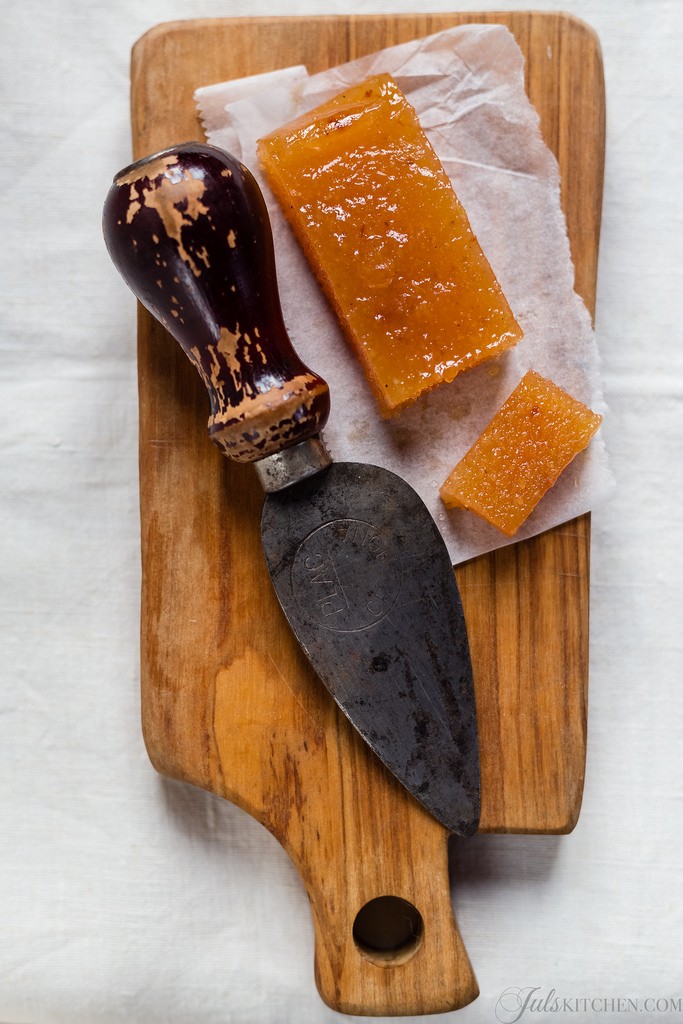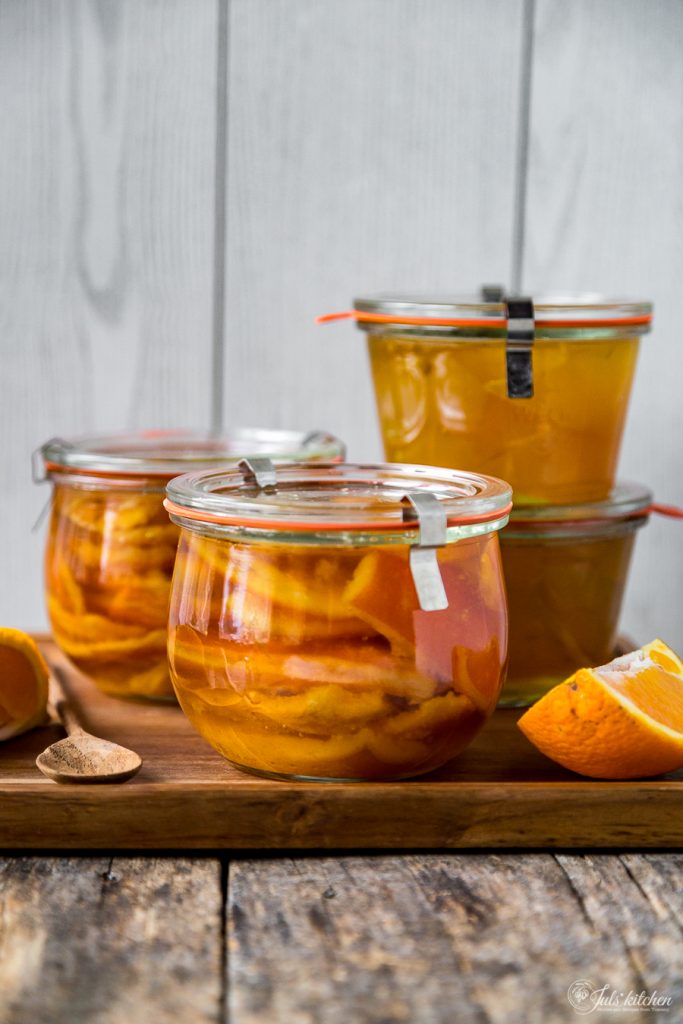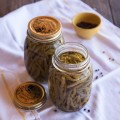Home-made holiday food gifts
Yesterday I photographed until five in the afternoon, until the light outside allowed me to see something on the set. When I looked up from my computer, I suddenly found myself in such a dark kitchen that I could hardly tell apart the shape of the tripod that stood out against the window. All around me dirty pots, greasy pans, vintage cutlery, cutting boards, moulds for cakes and wooden rulers, crumpled baking paper and pine cones painted in white, plastic containers with everything I had photographed, which would shortly become a dinner to be shared with my parents, a woollen sweater abandoned on the chair next to me, cables and battery chargers, notebooks with ingredients and recipe steps scribbled down in between one dish and the next.
A few hours to December the 1st, to the beginning of the Christmas month and to the holiday celebrations, and we had not been able to realise all that months ago, during the heat of summer, we had promised ourselves: a new calendar, as in 2015, and the cookie swap, as last year.
A feeling of slight discouragement had gripped me for a few days: once again I had fallen into the trap of expectations, of the things-that-must-be-done otherwise it is not Christmas.
Growing up, our Christmas tree has always been pretty bald and wonky, being it a real fir or a plastic one. In the last few years Tommaso and I bought a fake one, which has already started to lose its plastic green needles. When he found me enchanted in front of a real fir tree, with fat thick branches smelling of resin, the eyes of a child in front of a Christmas miracle, he put his arm around my shoulders and gently took me away.
– Why don’t we buy a real fir tree this year? Why don’t we buy THIS one?
– Giulia, we already have one.
– But it is ugly, it is worn-out…
– But we bought it together, it is our tree.
This was the first piece of a puzzle that this year, once again, for the umpteenth time, I felt the need to put together.
Yesterday evening, once we had washed all the dishes, dusted the flour from tables and cupboards, a preview of a snowy Christmas, tidied up plates, fabrics and decorations, I decided to prepare the Advent calendars for Tommaso and Claudia, waiting to have dinner with my parents. We have this tacit agreement at the end of the long days when I accumulate one or two photo shootings: I bring all the leftovers, and my mum lets me sit at the table where I don’t have to move a fork but share what I photographed during the day. Given our predispositions and preferences, we both win.
I instructed Tommaso not to enter the living room, I spread chocolates, candies, sweets and small surprises on the table and I turned on Netflix to find a movie suitable for those hours of creativity. Love Actually defeated all the competitors, as for fifteen years it has been my Christmas soundtrack.
While Hugh Grant was dancing down the stairs of Downing Street and Colin Firth was falling in love with a Portuguese girl writing a crime story in Marseille, on the notes of Joni Mitchell, Norah Jones and the Beatles I felt my anxiety melt away. I know it may sound cheesy, but in preparing the little parcels of the Advent calendar for two of the most important people in my life, my husband and my sister, in the simplicity of a common gesture, in anticipating their happiness in finding their favourite kind of chocolate, I realised once again that Christmas is here, in the little things, in the details that remind you of more happy days, with a shabby wonky tree in your living room.

So this year there are no surprises here on the blog, but there will be recipes, and home made food gifts, and three different menus, as this is what we do best, we bring you into the kitchen and we make you rediscover the pleasure of cooking. This is what we want to give you for this Christmas, and yearlong, recipes that work, which are not meant to surprise, but to nurture, which can be shared or enjoyed in a sacred solitude.
Home-made holiday food gifts
I schedule the year and the seasonal preserves in view of Christmas. It is just the two of us, we would not be able to finish all the jams, preserves, marmalades, liqueurs and pickles that I gradually stock up in the pantry. Actually, I do not even have a pantry, but I have a madia, the old fashioned cupboard where my great-grandmother used to make bread, which I meticulously cram with all sorts of jars. It’s my little pride, every now and then I open the cupboard and I smell that unmistakable aroma that is a mixture of history and seasonality.
When Christmas arrives, we mix and match liqueurs, cookies, jams and traditional sweets, based on our friends or family’s tastes and preferences: a ribbon, some colourful paper and a handwritten note, and the home-made holiday food gifts are ready.
Even in this case, they are just simple presents, but they show your presence. The time you dedicated to make them, the attention in the choice of ingredients and the proud smile with which you’ll give them, all this always makes the difference.

Pickled cauliflower giardiniera
The giardiniera is a collection of pickled vegetables preserved in olive oil, basically it is a small vegetable garden in a jar: I usually choose the most representative vegetables of the season, then I quickly blanch them in a pot filled with water, vinegar, sugar and salt, and then I preserve them in extra virgin olive oil. What requires more time is usually to clean all the vegetables and cut them into small pieces, because the cooking is short and respectful. Eventually, I hide the vegetables in the dark of my cupboard for a few weeks, when they will be finally ready to be tasted. I really love opening up a jar of home made giardiniera, the taste of vinegar makes me hungry, the colours of the vegetables cheerful.
This giardiniera is made only of cauliflower, but there are three varieties into one jar: there is the white one, the most common, then a green and a purple cauliflower. If I had named it preserved cauliflower it would not have had the same charm, this is the importance of the words you choose.
In this case the vinegar plays an important role not only for preservation and for the taste, but also for colour of the florets. If nothing happens to the white cauliflower, the green one tends to fade almost completely, while the purple cauliflower, thanks to the acidity of the vinegar, takes on an intense, bright pink colour. Unfortunately when I made up my mind to prepare this giardiniera, I could not find the yellow cauliflower, which I would have used instead of the green one. If you have a chance, try the yellow one: the flavour won’t change much, but the colours inside the jar will be a joy for your eyes.
A final word on the olive oil. I will never get tired of pointing out how important it is to use a good quality extra-virgin olive oil, because in this case all the flavour of the giardiniera will depend on it. Don’t despair if it looks like you’re using a great deal of olive oil: you can drizzle that olive oil over a slice of toasted bread, or use it to season a salad. It will be delicious.

How and when to eat the colourful pickled cauliflower giardiniera? We are at the height of winter, so there will be lots of steaming dish of boiled meat to match it. I also like to add a few florets to a mixed leaves tuna salad or to eat the giardiniera as an aperitivo with a few slices of toasted bread. You know, all that delicious olive oil…
Pickled cauliflower giardiniera
Print Recipe Pin Recipe Share by EmailIngredients
- 500 g of white cauliflower florets
- 250 g of purple cauliflower florets
- 250 g of green cauliflower florets, or yellow
- 2 l of white wine vinegar
- 1 l of water
- 140 g of sugar
- 60 g of salt
- 6 garlic cloves, with the skin on
- 2 tablespoons of black peppercorns
- Extra virgin olive oil
Instructions
- Divide the cauliflower into florets, keeping the colours separated.
- Take a large pot and pour in the vinegar, the water, salt and sugar. Stir to dissolve the salt and the sugar, then put it on the stove and bring it to a boil.
- Blanch the florets for a few minutes, until they are al dente: this means they should be quite soft, but with a bite. Cook the white cauliflower first, then the green cauliflower and finally the purple one.
- Remove the cauliflower florets from the pot with a slotted spoon and place them onto a clean cloth, leaving them to dry until the next day.
- Arrange the colourful florets in layers in sterilized jars, adding a clove of garlic and a few grains of black pepper in each jar. Press well the florets as to fill up any empty space.
- Pour in extra virgin olive oil to cover the florets completely. Check again after a few hours to see if you need to pour in more olive oil to completely cover the artichokes. Close the jars and store them for a few months in the pantry, or in a dry, cool and dark place. Be patient and keep them aside for at least 15 days before tasting them.
When we talk about preserved vegetables in olive oil, I am always a bit scared by botulism. So please read these articles and follow scrupulously their advice. The Need-to-Know Guide to Botulism, For Safe Canning & Preserving and In jams and jellies, acidity is the key to avoiding botulism.
– More home-made holiday food gifts from the blog archive –

1. Panforte
Panforte is a thick and dense cake of medieval origin. At first it was made by the monks in the monasteries and given as a symbolic gift in special occasions, then passed into the hands of the apothecaries: sugar, almonds, candied fruit and spices were ingredients as precious as gold, and like gold they were kept from these figures that were a cross between an alchemist and a pharmacist, in huge glass jars on dark wooden shelves… I like to imagine their shops just like Ollivander’s shop in Diagon Alley, for those who are fans of Harry Potter.
On the blog you can find three different recipe to make panforte:
- the traditional panforte, with almonds and candied orange and citron peel.
- fig and walnut panforte, made with ingredients which I usually connect to the Tuscan countryside: walnuts, the prodigious fruit of tall trees, which were considered as a shelter for witches, the essence of a dark bitter liqueur made during the night of St. John, and figs, generous trees which give us one of the most sensual fruit towards the end of summer, a taste of childhood and a warm sweet fullness.
- panforte bites, with candied fruit and nuts. These panforte bites are perfect for those who love dried and candied fruit, for those who like a sweet treat along with a good coffee, but not just the usual chocolate, for those who worship the tradition but have the desire to reinvent it by adding some spice and some new ingredients, for those who are still a child inside but want to set a tone as an adult with a piece of panforte and an espresso.

2. Quince paste
You must patiently pass the cooked quinces through a vegetable mill, without removing skin and seeds, in order to take advantage of pectin, a great thickening agent contained in the seeds. It’s a labour of love, it takes time, but the result is guaranteed! If you prefer instead a soft jam, omit this step, peel the quinces and remove all the seeds, then proceed to sterilize jars and fill them up as you would do in any preserve.
You can find the recipe here.
Once the quince paste is ready and set, you can dice it and wrap each cube in wax paper: place these old time candies in a big jar or in a paper bag for a timeless Christmas gift. If your friends are gourmands and curious eaters, keep the quince paste in a bar, wrap it in parchment paper and add it in a basket with a good aged cheese and some home made oat crackers.

3. Home made candied orange and citron peel
Over the last few years, since the production of panforte and cavallucci for Christmas took on pastry shop rhythms, I started to make my homemade candied orange peels and candied citron peels. Apart from the exorbitant cost of high quality artisanal candied peels, which is totally justified, given the amount of time it takes to make them, the taste of home-made candied peels has nothing to do with that of store bought, colouring bright, preservative rich ones. Making your own candied peels cuts down the costs and provides you with the most fragrant peels you’ll ever taste. Here you can find the detailed recipe to make you own candied orange and citron peels.
Home-made candied fruit can be essential if you want to make a proper panforte (to be kept for your Christmas or given as a gift), but are also a precious gift, because their heavenly scent, their intense taste of fresh citrus fruits and their dense and translucent texture reveal all the time you have spent preparing a heartfelt home made gift.

4. Home-made mustard
Not everyone is fond of sweets, not everyone wants to sit down in the evening with a piece of panforte to slowly nibble at, to make it last longer. Someone prefers robust and decisive flavours, one collects jars of sauces and dressings, or loves sandwiches with a strong character. If you know someone like this, homemade mustard is an unusual gift that can be prepared quickly and can be customised with nuts and herbs. Here you can find my recipe.

5. Marmalades
We are in the right season and citrus fruits are abundant and affordable. The bitter orange marmalade has an undeniable appeal: its bitterness makes it difficult to comprehend its charm, just like Woody Allen’s comic quality. When you get it, you fall in love, and there’s no coming back. The bergamot marmalade pushes the bitterness to an extreme level, balanced by an irresistible fragrance: open the jar and it’s like taking a bath in a cup of Earl Grey. This mixed citrus marmalade is balanced and cheerful. You taste the sweetness, the bitterness, an incomparable freshness and the lemon acidity. It makes you love it, and for this reason it is perfect as a gift, because you can enjoy it on toast for breakfast, as a filling for a sponge cake or as an ingredient to glaze a piece of pork to caramelise in the oven.
Here on the blog you can find:

6. Home-made cookies for Christmas
Even though now I am so lucky to spend the whole day in the kitchen, baking cookies as a gift has still an irresistible naive charm. This is how I like to treat myself with a little scented pleasure. A few years ago I picked my 10 favourite Christmas cookies, something you can make in advance as a gift, or a sweet treat you can save to enjoy in a relaxing moment on the couch. To those cookies I would add now the Pitigliano sfratti, the white chocolate and pistachio biscotti, and the chocolate barks with nuts.







Just an enormous thank you for transporting me to Tuscany again and again, and for the gift of your prose, elegance, and recipes. You made my Monday!
Oh Janice, thank you so so very much for your words, they pay for all the hours spent writing and testing the recipes. It is a process I truly enjoy, but such a warm feedback makes it double worth!
I plan on making your budino di riso this weekend! I will send pictures :)!!